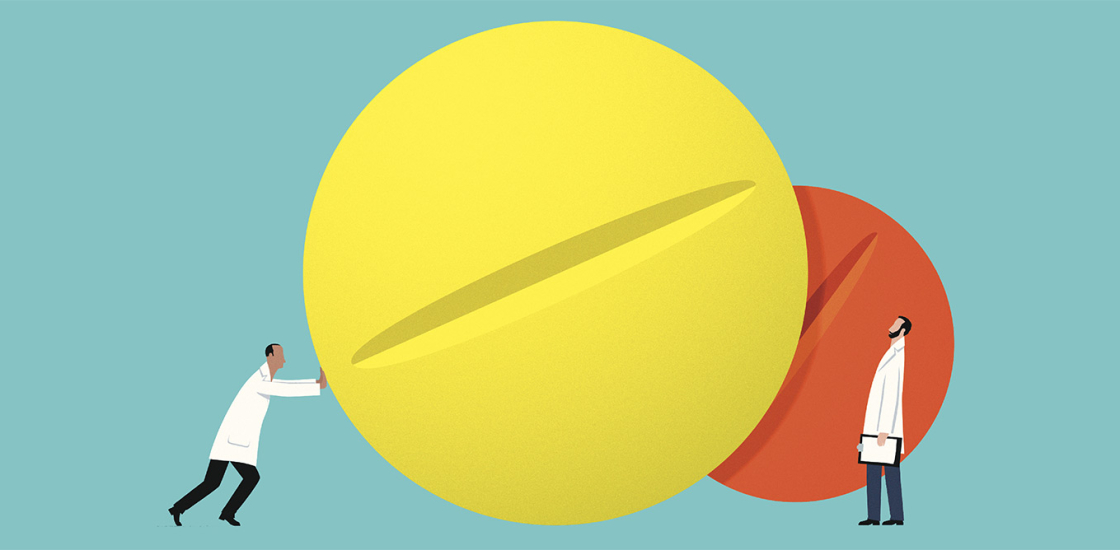THIS ARTICLE IS MORE THAN FIVE YEARS OLD
This article is more than five years old. Autism research — and science in general — is constantly evolving, so older articles may contain information or theories that have been reevaluated since their original publication date.

When a boy scrapes his knee and his mother says, “Let me kiss it,” what is the active ingredient in his recovery? Should that same boy fall on the football field, his coach might sigh and say, “Rub dirt on it.” Now, if the coach suggested kissing the boy’s knee or the mother recommended a dose of dirt, the experience of those same treatments might be very different indeed.
Contrary to the lyrics of “As Time Goes By,” a tune popularized by Frank Sinatra, a kiss is seldom just a kiss. That is, the context in which we administer a treatment matters. And in the search for new and better treatments for individuals with autism, context can make the difference between success and failure.
In clinical trials, we attempt to overcome context with a placebo pill. The belief is that if we can hide the treatment among a perfect counterfeit, we can pinpoint its true effects in a sea of environmental complexity. But a pill is never just a pill.
The playground for the placebo effect, where it has the chance to flourish, is in trials testing treatments for complex disorders. The causal mechanisms for these disorders are often unknown, and the treatment’s mechanism of action is often poorly or incompletely understood1.
Heterogeneity can make things even more complicated. The efficacy of the playground kiss, for example, might depend on whether the scrape is superficial or deep, and on the child’s tolerance for pain. Studies have consistently shown that people who enter a study with relatively mild symptoms are more likely to experience placebo responses than those who have more severe symptoms2. And the greater the number of study sites, the greater the opportunity for the placebo effect to take up residence3.
Also, the more subjective the ‘outcome measure’ — the benchmark for a treatment’s effectiveness — the more opportunity exists for bias. Some trials rely almost exclusively on caregiver reports or clinician observation to gauge a treatment’s effects, opening the door for ‘placebo-by-proxy’ among hopeful onlookers4. A parent may be inclined to rate the effectiveness of kisses more highly than the child does.
Solution search:
All of the aforementioned elements are not only present in autism trials, but amplified. The therapeutic ‘kiss’ is delivered in a context in which we might collect videotapes, draw blood, ask if things are getting better (over and over), and do it all in a high-tech clinical environment humming with success and in which the participant and family are surrounded by some of the nicest people on the planet. At least, this is the case where I work, in Seattle.
One way to solve these issues is, simply, big numbers. The larger the trial, the greater the odds of detecting small differences between treatment and placebo conditions. Unfortunately, large trials are lengthy and expensive. And in autism, large trials may boost the heterogeneity among study participants.
Another strategy is to attack expectancy bias head-on: Tell people that the treatment is a long shot and that they may not even get it. This, of course, is not a clever recruitment strategy. And even if parents know that their child is as likely to receive a placebo as the actual treatment, it’s human nature to assume you’ll be lucky. After all, even smart people still buy lottery tickets. At least in Seattle.
Another approach is to try to weed out the placebo responders. This strategy is based on the belief that the response to a placebo is qualitatively or quantitatively different from the response to an active treatment, making it possible to identify those who improved from the placebo alone. But in most studies, this belief does not hold up5. The responses to placebo are as good or better than those to an active drug in every way.
Having more objective outcome measures that are sensitive to subtle changes, such as computer tasks, may seem like an obvious solution to this problem. But if a drug’s effects aren’t clinically obvious — that is, clearly evident both objectively and subjectively — the likelihood that the more objective outcome is actually meaningful is probably low.
Thankfully, the field is moving in other, more productive directions that will help us evaluate treatments. We’re learning more about the pathways that underlie the development of autism. And genetic studies are revealing subgroups of people with the disorder who may respond more uniformly to a particular treatment.
These genetic advances are also guiding the development of new, targeted treatments, such as the use of metabotropic glutamate receptor blockers in fragile X syndrome6. With better, more objective outcome measures, autism researchers may be able to test these interventions using strategies such as the National Institute of Mental Health’s ‘fast-fail’ program, by which treatments that have no measurable effect on their physiological targets can be quickly abandoned.
We need a range of treatments in our therapeutic playground. And we need to match them to individuals in specific contexts to maximize their effectiveness. In other words, some people need a kiss, others need dirt, and a few need a ride to urgent care.
We must continue working to weed out the placebo effect from clinical trials in autism. But we would also do well to learn more about the effect’s active ingredient and how to turn up its volume. Doing so could augment every intervention we choose to use. That is something that, in the words of Sinatra, no one can deny.
Bryan King is vice chair of psychiatry and behavioral sciences at the University of Washington and director of the Seattle Children’s Autism Center.

By joining the discussion, you agree to our privacy policy.